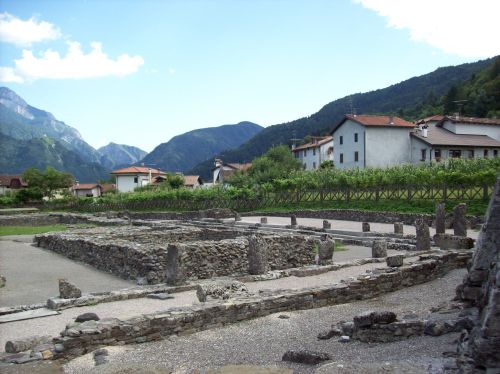
Beltane is the Celtic cultural fire festival celebrated in early May each year by thousands of Pagans. Dancing the Maypole, celebrating the return of longer days and warmer sunlight, and the fertility of the land are all facets of this festival. But the root of Beltane as a celebration of sacred fire is deeper than just Celtic cultures.
The common ancestors for anyone with heritage from Western to Eastern Europe, and south into India, are the Indo-Europeans. Around 6,000 years ago, the Indo-Europeans descended from the Pontic-Caspian Steppe, a region today found in Ukraine and Russia, and spread out into the Mediterranean, to the British Isles, into Scandinavia, and as far as Persia and India.
Although they left no written texts, archaeology from periods succeeding their time has led scholars to conclude that the Indo-Europeans held two principles in high honor: natural wellsprings and the flame. Both of these sacred elements are present in many pagan rituals, and no less than at Beltane. Indo-Europeans would light a sacred fire using mirrors or glass to reflect the sun. The flames for other fires would be taken from this first sacred fire, and distributed or collected by families for their hearth.
In ancient Greece, this practice was continued with respect to Hestia, goddess of the hearth, the first and last of the gods in Hellenic tradition. If the home flame were to die out, the new flame would be taken from the nearest temple’s eternal flame and carried home.
This tradition continues similarly today in modern Greece with the celebration of Orthodox Easter, falling on or around Beltane each year. The sacred flame is lit in Jerusalem, although the mystery of how it is lit is not disclosed. The first priest takes the flame from the cave of Jesus’ tomb and passes it to the next, and to all present. These flames are then flown specifically to each island and village church in Greece and across the Eastern Orthodox world to light the flames of each church.
At the close of the midnight liturgy service for Easter, it is common across all of Greece to see people walking or driving home from church with sacred flames cupped in their hands against the wind. Once home, the ancient tradition of the hearth fire is maintained. Each entrance to the home is blessed, and then the flame is touched to all home candles on the eikonostasi. Translating as the “beautiful corner”, this is a space in the home similar to the lararia or hearth altars of Hellenic and Roman practice, where today blessings and prayers are left to saints instead of gods.

Beltaine Fire [Photo Credit: MJTM]
Indo-Europeans are also thought to have used fire in ritual cleansing, much like their later Celtic ancestors. Old Irish literature, including the Sanas Cormaic and Tochmarc Emire, explain Beltane. Traditionally at Beltane, celebrations include driving the cattle through fires as purification and protection. Celtic homes would douse their home fires and replace them with the Beltane bonfire’s sacred flames. At Beltane, visiting holy wells is also practiced, something Indo-Europeans held sacred as well.
Though we cannot know the full extent of the practices of the Indo-Europeans, as theirs was a preliterate society, we know that they worshiped or otherwise regarded deities of the sun, the moon, the dawn, the sky, and the earth, and honored the elements, just like Ireland and other Celtic peoples. There is also some speculation that the names of the gods worshiped on Celtic lands are rooted in Proto-Indo-European, a language reconstructed by looking for common roots in the European languages of today.
Belanus, the healing god from which Beltane gets its name, is thought to derive his name from Proto-Indo-European. There are two main theories for his name’s root: bel- meaning “white, shining”, or gwelH– meaning “spring.” Although he has no association with fire, he was associated with water and healing springs – in fact, in Rome, he was worshiped alongside nymphs at the Iulium Carnicum thermal springs. Healing is often associated with springs and water in many cultures, and “the fires of Bel” is a possible meaning of the word “Beltane.”

Zuglio (UD) – foro della città romana di Iulium Carnicum ]Photo Credit: Seb1 CC BY-SA 3.0]
Although Belanus was not a fire deity in prehistory or ancient Celtic times, during and after the Roman occupation, his worship changed. As the Roman Empire spread across Celtic lands, Belanus’ worship continued, but the god grew increasingly conflated with Apollo. As Apollo is a god of the sun, Belanus became more associated with the sun as well. It wasn’t just in the British Isles that Apollo and Belanus began to merge, but in Rome’s Mediterranean territories as well, as Belanus’ altar at the Iulium Carnicum springs attests in modern-day north Italy. It is perhaps after the Roman influence that we see Beltane takes its name, as Apollo’s conflation with Belanus explains the festival’s associations with fire and the sun.
History shows us that Beltane celebrations have always been flexible and adaptable to the people who celebrate them. Today the holiday is celebrated globally, by Celtic and non-Celtic revelers alike. Celebrations incorporate multicultural customs and newer practices, carrying on the tradition of our ancestors and their adaptability.
The sacred flame is hot at the center of any Beltane ritual, past or present.
The Wild Hunt is not responsible for links to external content.
To join a conversation on this post:
Visit our The Wild Hunt subreddit! Point your favorite browser to https://www.reddit.com/r/The_Wild_Hunt_News/, then click “JOIN”. Make sure to click the bell, too, to be notified of new articles posted to our subreddit.
